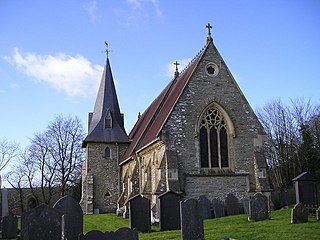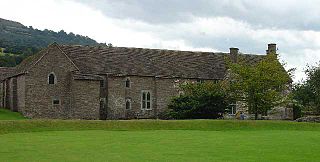
Harlech is a seaside resort and community in the North Wales county of Gwynedd. Before 1974 it was in the historic county of Merionethshire. It lies on Tremadog Bay in the Snowdonia National Park. Before 1966 it belonged to the Meirionydd District of the 1974 County of Gwynedd. Its landmark Harlech Castle was begun in 1283 by Edward I of England, captured by Owain Glyndŵr, and in the 1480s a stronghold of Henry Tudor. Once on a seaside cliff face, it is now half a mile inland. New housing has appeared in the low town and in the high town around the shopping street, church and castle. The two are linked by a steep road called "Twtil". Of its 1,447 inhabitants, 51 per cent habitually speak Welsh. The built-up area with Llanfair had a population of 1,762 in the 2001 census, over half of whom lacked Welsh identity, and of 1,997 in the 2011 census. The estimate in 2019 was 1,881.

Llanfynydd is a village, parish and community in Carmarthenshire, Wales. The community population at the 2011 census was 499. It lies some 10 miles north-east of the county town, Carmarthen. Bordering it are the communities of Llansawel, Talley, Manordeilo and Salem, Llangathen, Llanegwad and Llanfihangel Rhos-y-Corn, all in Carmarthenshire.

Saint Cynllo is a British saint, who lived in the late 5th and early 6th centuries, generally described as a brother of Saint Teilo. Cynllo was known for "...the sanctity of his life and the austerity of his manners."

Llangynllo railway station is a countryside stop in Powys about 5 miles west of Knighton, on the Heart of Wales Line. The station is located 1.4 miles north of Llangunllo village, at road level beside two houses on a minor rural road off the B4356 road.
Lewys Glyn Cothi, also known as Llywelyn y Glyn, was a prominent 15th century Welsh poet who composed numerous poems in the Welsh language. He is one of the most important representatives of the Beirdd yr Uchelwyr or Cywyddwyr ("cywydd-men"), the itinerant professional poets of the period between the 1284 Statute of Rhuddlan and c. 1600.

Llanegwad is a community located in Carmarthenshire, Wales. The population taken at the 2011 census was 1,473.
Rice Rees was a Welsh cleric and historian.

Castell Moel is the remains of a 16th-century fortified manor house in the community of Llangain in Carmarthenshire, Wales, and also a medieval motte about 600 yards (550 m) to the south of the manor house. The remains are approximately 2.5 miles (4.0 km) south-west Carmarthen and 0.8 miles (1.3 km) north-east of the village of Llangain. Three miles to the north-west is Carmarthen Castle, and five miles to the south-west is Llansteffan Castle.
Nidan was a Welsh priest and, according to some sources, a bishop, in the 6th and 7th centuries. He is now commemorated as a saint. He was the confessor for the monastery headed by St Seiriol at Penmon, and established a church at what is now known as Llanidan, which are both places on the Welsh island of Anglesey. He is the patron saint of two churches in Anglesey: St Nidan's Church, Llanidan, built in the 19th century, and its medieval predecessor, the Old Church of St Nidan, Llanidan. Midmar Old Kirk in Aberdeenshire, Scotland, is also dedicated to him: Nidan is said to have helped to establish Christianity in that area as a companion of St Kentigern. St Nidan's, Llanidan, has a reliquary dating from the 14th or 16th century, which is said to house his relics.
The White Book of Hergest was an important Welsh manuscript compiled in c. 1450. It contained many Welsh poems and prose texts and was a significant source for several antiquaries of the 17th and 18th centuries, but disappeared in the early 19th century, probably being destroyed in a fire in a London bookbinder's shop in around 1810.

Sir Roger Vaughan of Tretower Court, was the son of Welsh noblewoman Gwladys ferch Dafydd Gam and Sir Roger Vaughan of Bredwardine, who fought and died with Gwladys's father, Dafydd Gam in the Battle of Agincourt in 1415.
Thomas Evans, was a Welsh poet, Unitarian, and political activist.

Saint Eigen, Eurgen, Eurgain or Eurgan was the legendary, and possibly historical first female Christian saint. Her name has doubtfully been linked to two Welsh churches and is found in manuscripts from the collection of Iolo Morganwg making historical evidence of her existence dubious and limited.

The Coelbren y Beirdd is a script created in the late eighteenth century by the literary forger Edward Williams, best known as Iolo Morganwg.
Saint Cennych was a Pre-congregational saint of medieval, South Wales.
He is the patron Saint of Llangennych, Carmarthenshire.
Saint Gwrddlew or Gwrtheli, Gartheli, was a pre-congregational saint of the 5th century medieval, Wales.
Saint Gwrfyw, was a pre-congregational saint of medieval Wales.

Saint Eigrad was a sixth-century Welsh saint and the founder of the St Eugrad's Church in Llaneugrad, Anglesey.

A Saint Ilar is listed among the 6th-century saints of Wales and is the probable namesake of Llanilar in Ceredigion and its former hundred of Ilar. His feast day is variously given as 13, 14, or 15 January, but is no longer observed by either the Anglican or Catholic church in Wales.

This is a bibliography of published works on the history of Wales. It includes published books, journals, and educational and academic history-related websites; it does not include self-published works, blogs or user-edited sites. Works may cover aspects of Welsh history inclusively or exclusively.












